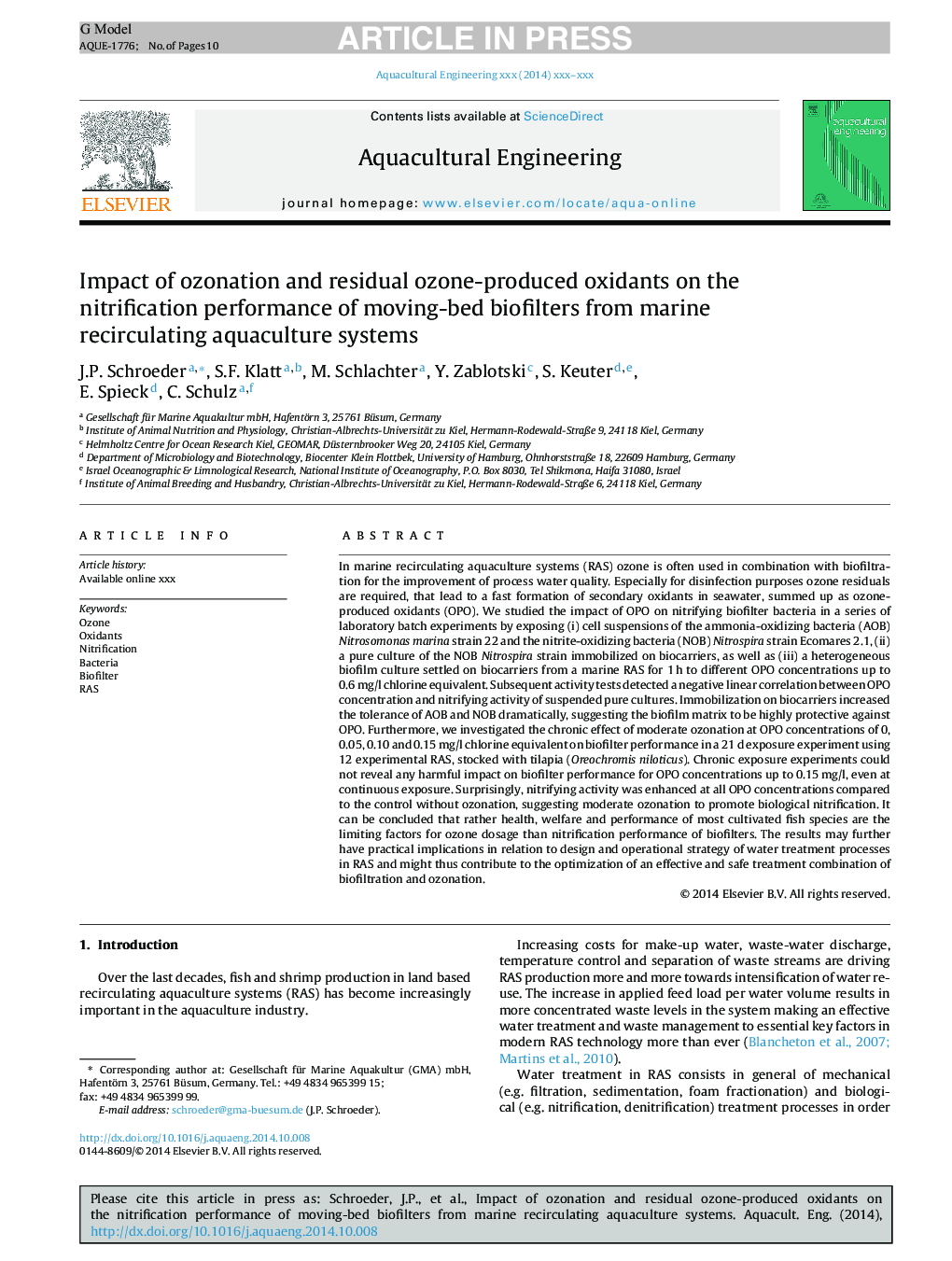| کد مقاله | کد نشریه | سال انتشار | مقاله انگلیسی | نسخه تمام متن |
|---|---|---|---|---|
| 6381327 | 1625705 | 2015 | 10 صفحه PDF | دانلود رایگان |
عنوان انگلیسی مقاله ISI
Impact of ozonation and residual ozone-produced oxidants on the nitrification performance of moving-bed biofilters from marine recirculating aquaculture systems
ترجمه فارسی عنوان
تاثیر ازونیت و اکسیدان های تولید شده ازن باقی مانده بر عملکرد نیتریفیویت از فیلترهای زیستی حرکتی از سیستم های آبزی پرورش دریایی
دانلود مقاله + سفارش ترجمه
دانلود مقاله ISI انگلیسی
رایگان برای ایرانیان
کلمات کلیدی
موضوعات مرتبط
علوم زیستی و بیوفناوری
علوم کشاورزی و بیولوژیک
علوم آبزیان
چکیده انگلیسی
In marine recirculating aquaculture systems (RAS) ozone is often used in combination with biofiltration for the improvement of process water quality. Especially for disinfection purposes ozone residuals are required, that lead to a fast formation of secondary oxidants in seawater, summed up as ozone-produced oxidants (OPO). We studied the impact of OPO on nitrifying biofilter bacteria in a series of laboratory batch experiments by exposing (i) cell suspensions of the ammonia-oxidizing bacteria (AOB) Nitrosomonas marina strain 22 and the nitrite-oxidizing bacteria (NOB) Nitrospira strain Ecomares 2.1, (ii) a pure culture of the NOB Nitrospira strain immobilized on biocarriers, as well as (iii) a heterogeneous biofilm culture settled on biocarriers from a marine RAS for 1Â h to different OPO concentrations up to 0.6Â mg/l chlorine equivalent. Subsequent activity tests detected a negative linear correlation between OPO concentration and nitrifying activity of suspended pure cultures. Immobilization on biocarriers increased the tolerance of AOB and NOB dramatically, suggesting the biofilm matrix to be highly protective against OPO. Furthermore, we investigated the chronic effect of moderate ozonation at OPO concentrations of 0, 0.05, 0.10 and 0.15Â mg/l chlorine equivalent on biofilter performance in a 21 d exposure experiment using 12 experimental RAS, stocked with tilapia (Oreochromis niloticus). Chronic exposure experiments could not reveal any harmful impact on biofilter performance for OPO concentrations up to 0.15Â mg/l, even at continuous exposure. Surprisingly, nitrifying activity was enhanced at all OPO concentrations compared to the control without ozonation, suggesting moderate ozonation to promote biological nitrification. It can be concluded that rather health, welfare and performance of most cultivated fish species are the limiting factors for ozone dosage than nitrification performance of biofilters. The results may further have practical implications in relation to design and operational strategy of water treatment processes in RAS and might thus contribute to the optimization of an effective and safe treatment combination of biofiltration and ozonation.
ناشر
Database: Elsevier - ScienceDirect (ساینس دایرکت)
Journal: Aquacultural Engineering - Volume 65, March 2015, Pages 27-36
Journal: Aquacultural Engineering - Volume 65, March 2015, Pages 27-36
نویسندگان
J.P. Schroeder, S.F. Klatt, M. Schlachter, Y. Zablotski, S. Keuter, E. Spieck, C. Schulz,
